|
 Flagelloscypha pseudopanax Flagelloscypha pseudopanax
SynonymsLachnella pseudopanax
Cyphella pseudopanax
BiostatusPresent in region - Indigenous. Endemic
Images (click to enlarge)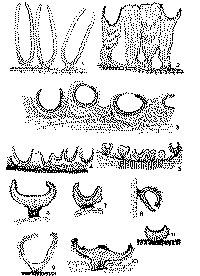
Caption: FIG. 8: Section through pendent pileus of Cyphella pseudopanax. | 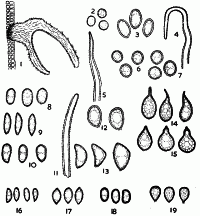
Caption: FIG. 17: Spores of Cyphella pseudopanax. | 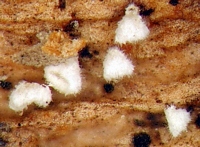
Caption: fruitbodies
Owner: J.A. Cooper | 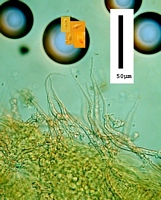
Caption: peripheral tapered hairs with crystal encrustation and spores.
Owner: J.A. Cooper | 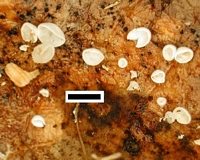
Caption: scale = 2mm
Owner: J.A. Cooper | 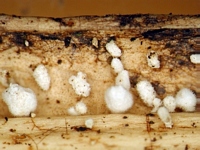
Owner: J.A. Cooper | 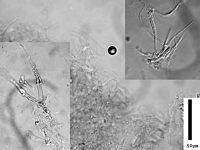
Caption: inflated hyphae in hymenium and abhymenial hairs twined at base.
Owner: J.A. Cooper | 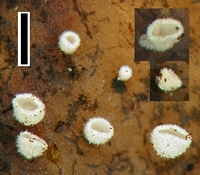
Caption: scale=1mm
Owner: J.A. Cooper | 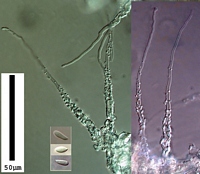
Caption: encrusted flagella-like hairs and spores
Owner: J.A. Cooper | 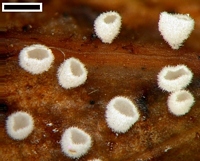
Caption: scale=0.5mm
Owner: J.A. Cooper |
Article: Cooke, W.B. (1961). The cyphellaceous fungi. A study in the Porotheleaceae. Beihefte zur Sydowia 4: 144 p.
Description: Receptacles scattered, waxy, fragile, 0,2-0,5 mm. in diameter, attached by a narrow base,
cupulate or as often pendant; exterior white, drying cream, tomentum of long, unbranched,
aseptate hyphae, tortuous, 3 µ diameter, finely crystal coated, tapering gradually to long-acuminate
apices; margin inturned, lacerate when old; hymenial surface concave, even, pallid
buff or cream; context white, to 40 µ thick, base to 250 µ of parallel hyphae radiately
arranged; generative hyphae to 2,5 µ in diameter, wall 0,25 µ thick, sparsely branched,
septate; hymenial layer to 35 µ deep, paraphyses subclavate; basidia subclavate, 12-16 x 7- 8
µ 4-sterigmate ; spores broadly fusiform or lemon-shaped, apiculate, 6-9 x 4,5-5,5 µ smooth,
hyaline.
Habitat: Habitat: On Pseudopanax crassifolium.
Notes: The above description was taken from Cunningham (1953). The writer would add that the
surface hairs are 150-250 X 5-6 µ arising directly from the context hyphae without apparent
septation; all hyphae and the base of the basidia possess clamps.
Article: Cunningham, G.H. (1948). New Zealand Polyporaceae. 3. The genus Polyporus. New Zealand Department of Scientific and Industrial Research, Plant Diseases Division, Bulletin 74: 39 p.
Description: Pilei annual, scattered, waxy, fragile, 0.2-0.5 mm. diameter, attached by a narrow base,
cupulate or as often pendent; exterior white, drying cream, tomentum of long, unbranched
aseptate hyphae, tortuous, 3 µ diameter, finely crystal coated, tapering gradually to long-acuminate
apices; margin inturned, lacerate when old; hymenial surface concave, even, pallid
buff or cream. Context white, to 40 µ thick, base to 250 µ, of parallel hyphae radiately
arranged; generative hyphae to 2.5 µ diameter, wall 0.25 µ thick, sparsely branched, septate.
Hymenial layer to 35 µ deep, paraphyses subclavate. Basidia subclavate, 12-16 x 7-8 µ, 4-spored.
Spores broadly fusiform or lemon-shaped, apiculate, 6-9 x 4.5-5.5 µ, smooth, hyaline.
Habitat: HABITAT. Scattered on bark of dead stems.
Distribution: DISTRIBUTION. New Zealand.
Notes: Tomentum hairs are long, unbranched, thin-walled and taper gradually to acuminate finely
crystal-coated apices, the main stem being covered with coarse crystals.
|